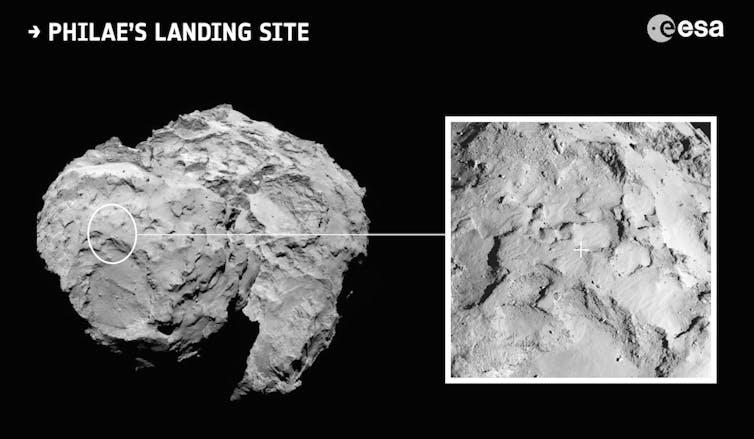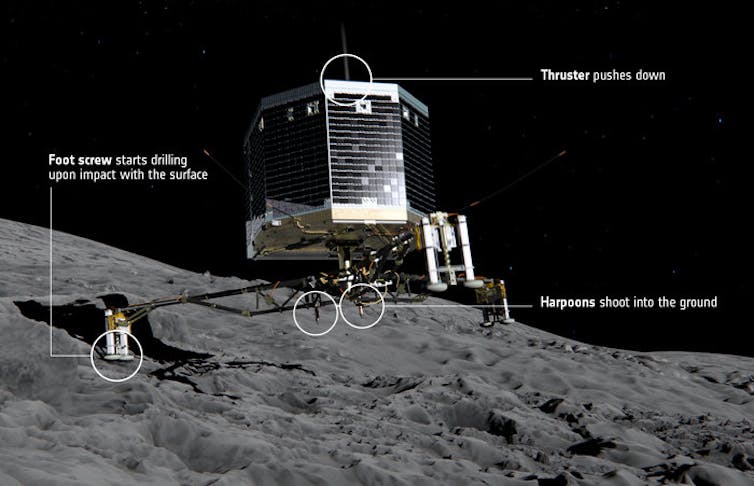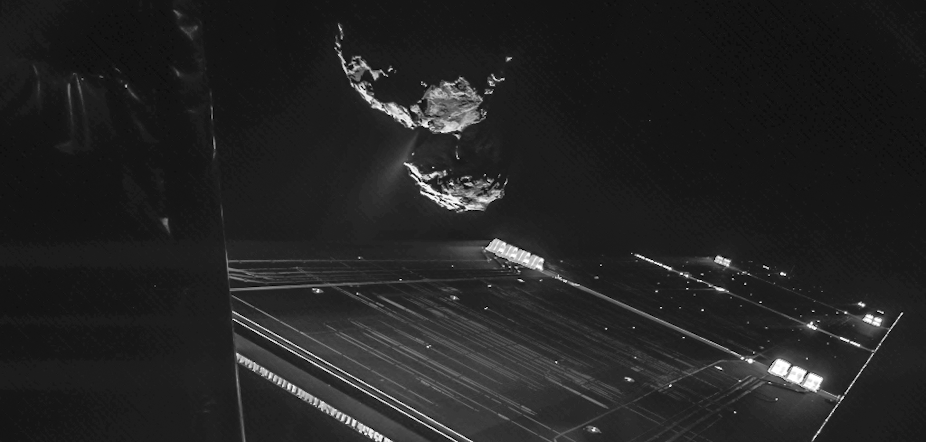The first ever attempt to land on a comet is set to be carried out by the European Space Agency (ESA) this Wednesday evening (AEDT). It is part of an exciting and highly successful space mission, which saw the Rosetta spacecraft become the first to orbit a comet last August. Now, the craft is ready to take on its next major challenge.
At an estimated time of 7:35pm Wednesday (AEDT), Rosetta will be approximately 20km from the surface of Comet 67P/Churuymov-Gerasimenko when it’s due to deploy a small lander, called Philae, to softly touch down on the comet’s surface.
Philae’s descent will take around seven hours and mission controllers will have to wait a further 28 minutes for Philae’s signal to travel across space and reach Earth. In all, ESA expects to receive confirmation of the touchdown around 3am, Thursday (AEDT).
Space exploration is all about intricate and detailed planning and that’s what the last 20 years have meant for the Rosetta mission. But this slow lead up is about to unleash a tense 24 hours as all of the hard work by ESA is put to the test in a nail-biting adventure.
A comet like no another
A real bonus for this mission has been that the target – Comet 67P/Churuymov-Gerasimenko – is so wonderfully interesting. Its distinct two-bodied shape is unlike any of the other comets that have been viewed up-close in space.
During September and October, Rosetta’s orbit was lowered until it was just 8km above the surface of the comet to provide a detail view of potential landing sites. It shouldn’t be underestimated what an ambitious mission this is - to journey to a completely unknown object and then try to determine a place to land. The chosen site is now called Agilkia and is found on the smaller of the two lobes which make up the comet.

Catch me a comet
In the history of space exploration, successful landings have only occurred on six objects: two planets (Venus and Mars), two moons (Earth’s moon and Saturn’s Titan) and two asteroids (433 Eros and Itokawa). The attempt to bring this number to seven and be the first landing for a comet is really out of this world.
ESA astronaut Alexander Gerst used the weightlessness of the International Space Station to demonstrate the scale of this feat and the complexities that are involved. After all, Philae is being dropped from a moving platform to meet up perfectly with the comet which itself is both spinning and moving.
You can even give it a try yourself, with this game designed for kids by NASA and you’ll really get a feel for just how small the target region is.
Go/No-Go decision time
The lead up to Philae’s separation with Rosetta will be marked by four Go/No-Go decisions. These are planned for the following times on Wednesday Australian time, but are subject to change due to the dynamic nature of the mission. If a decision results in a No-Go, there will be an abort and attempts will be made to try again, where possible and with a revised timeline.
The first Go/No-Go will occur at 6:30am AEDT to confirm that Rosetta is on the correct orbit. The second will take place at 11am AEDT to confirm that final instructions can be uploaded to Rosetta. At 12:35pm AEDT, the third Go/No-Go will check in on the status and health of Philae.
Rosetta will then need to fire thrusters for around six minutes between 5pm AEDT and 6pm AEDT to set it on the correct course for releasing Philae. A final Go/No-Go will occur between 5:35pm AEDT and 6:35pm AEDT to confirm that all is ready for the separation.
Everything going well separation will be registered on Earth at 8:03pm AEDT which is 28 minutes after the event itself to allow for the signal to travel the 500 million kilometres across space.
Release and capture
Just minutes after Philae is released it will snap a farewell image of Rosetta. These images, along with images that show its approach towards the comet’s surface, are expected to be downloaded to Earth within several hours after the separation. All of Philae’s data has to be sent via Rosetta and the communication loop is expected to be up and running just two hours after Philae is released.
During the descent Philae will also be sampling the dust, gas and plasma surrounding the comet nucleus. Another exciting thing about this mission is that Rosetta is watching a comet wake up and become active. When Rosetta first approached the comet, the ‘neck region’ situated between the comet’s two lobes was the most active and showed distinct jets of dust.
Just a few months later, as the comet slowly approaches the sun, dust is now being ejected across most of the comet, including from the comet’s smaller lobe. About one kilometre from Agilkia there are indications that new areas of activity could be developing, which will give Philae a ring-side seat.

The key will be making sure that Philae stays on the surface of the comet and doesn’t bounce back into space at the end of its descent. The lander has three legs that will unfold once it is released from Rosetta. The legs are designed to absorb the shock of landing and they have ice screws to secure the lander to the surface. The legs can also rotate, lift or tilt which will be useful if Philae needs to be brought back into an upright position.
Furthermore, the comet’s gravity is so slight that the lander will also fire harpoons to tether it to the surface and keep it there as the comet becomes more active.
We’ve arrived - now what?
Science experiments on the surface of the comet will begin quickly, around an hour after touchdown. It’s hoped that Philae will have enough power to last until March 2015. That’ll be the mission end, as the comet will have approached too close to the sun and Philae’s instruments will over heat.
But it all depends on how well the lander’s batteries can recharge via the solar panels. The primary battery has just 2.5 days worth of power, so it’ll be a flurry of activity to gather as much data as possible during that time just in case.
The lander is fitted with ten instruments including a drill that can dig down to 23cm. The sample can then be placed into one of 26 ovens to release the trapped and frozen gases and determine what the comet is made of.
Adventures like these that really push the limits of our capability is what space exploration is all about. This mission has already provided a huge boost to our understanding of comets, which in turn provides insights into the early history of the solar system. If Philae is successful it will be a great example of what can be achieved.

